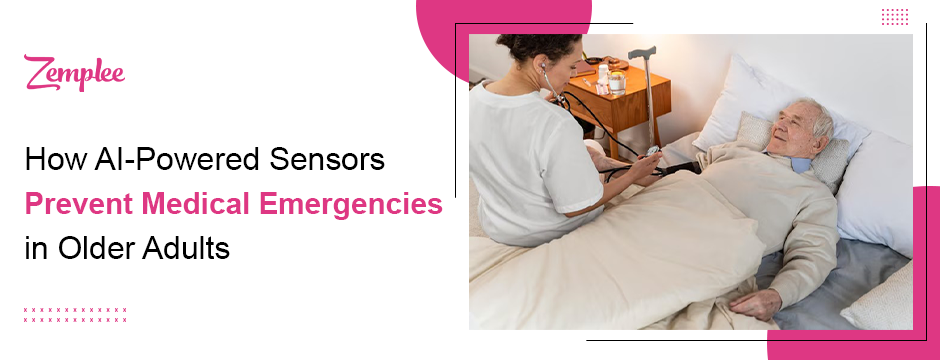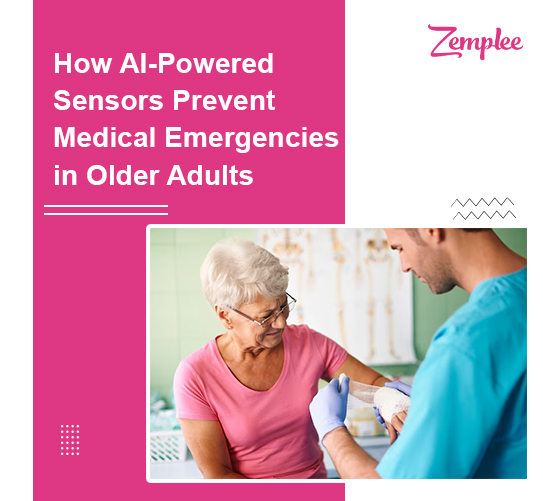As the global population ages, ensuring the health and safety of older adults has become a pressing priority. Traditional caregiving methods, while effective, often rely heavily on human intervention, which can be inconsistent, costly, or unavailable—especially for seniors who live alone or in remote areas. This is where technology, particularly AI-powered sensors, is stepping in to transform elderly care.
Thanks to the rapid advancement of elderly care tech, we now have intelligent, non-invasive systems that can track vital signs, detect anomalies, and alert caregivers in real-time—often preventing medical emergencies before they escalate. These breakthroughs are not only empowering older adults to live independently but also giving families and caregivers the confidence that help is never too far away.
In this comprehensive blog, we’ll explore how AI-powered sensors work, what makes them revolutionary in the context of elderly care monitoring, and how platforms like Zemplee are leading the charge in redefining remote care for seniors.

Understanding AI-Powered Sensors in Elderly Care
What Are AI-Powered Sensors?
AI-powered sensors are advanced monitoring devices embedded with artificial intelligence capabilities. They do more than simply collect data—they analyze it in real time to detect deviations from normal patterns and predict potential emergencies. These sensors can be embedded in wearables, placed strategically around the home, or integrated into smart home systems.
Key features include:
- Real-time data collection (e.g., heart rate, respiration, movement)
- Predictive analytics powered by machine learning
- Automated alerts and notifications to caregivers or healthcare professionals
- Continuous adaptation and learning of individual behavior patterns
Common Types of AI Sensors Used in Elderly Care
Vital Sign Monitoring Sensors
These are typically embedded in wearable devices such as smartwatches or chest bands. They continuously track metrics like heart rate, oxygen saturation, and blood pressure. AI analyzes this data to detect abnormalities that could indicate conditions like arrhythmias, hypertension, or respiratory distress.
Motion and Fall Detection Sensors
Strategically placed around the home or integrated into wearables, these sensors detect irregular movement patterns or sudden impacts that suggest a fall. The AI can differentiate between normal movements and emergencies, drastically reducing false alarms.
Environmental Sensors
These monitor ambient conditions—like room temperature, air quality, or humidity—which can directly impact seniors with respiratory or cardiovascular conditions.
Bed and Chair Sensors
Pressure-sensitive sensors on beds and chairs can detect when a senior hasn’t moved for an unusually long period, suggesting possible unconsciousness or immobility due to a medical emergency.
How AI-Powered Sensors Prevent Medical Emergencies
1. Early Detection of Health Deterioration
One of the greatest advantages of AI in elderly care tech is its ability to recognize subtle changes that may precede a health crisis. For example, a decline in mobility, increased heart rate variability, or irregular sleep patterns may be early indicators of infections, cardiac issues, or even neurological problems.
AI-powered elderly care monitoring devices continuously learn a senior’s normal patterns. When an abnormal deviation is detected, the system can immediately alert caregivers or physicians—often before the individual realizes something is wrong.
Example: An AI-enabled wearable may detect an elevated heart rate during sleep and decreased mobility the next day. This could indicate an oncoming infection or cardiovascular event, prompting early medical evaluation.
2. Fall Detection and Response
Falls are a major contributor to injuries and fatalities among the elderly. Traditional alert systems require manual activation, which may not be feasible if the individual is unconscious or disoriented.
AI-powered fall detection sensors can automatically recognize a fall through motion analytics and sound detection. Once identified, they instantly send alerts to emergency services or family members. Some systems even include two-way communication, enabling immediate interaction.
Stat Fact: According to the CDC, about 36 million older adults fall each year—resulting in over 32,000 deaths. Smart fall-detection sensors can significantly reduce these risks.
3. Medication Adherence Monitoring
Missing medication can lead to severe complications for seniors managing chronic conditions. AI sensors can be integrated into smart pill dispensers to ensure the correct dose is taken at the right time.
The system can track whether a pill was removed and taken, and alert caregivers if a dose was skipped. Over time, the AI can even analyze adherence patterns and predict future non-compliance, helping in care plan adjustments.
4. Behavioral and Mental Health Insights
AI doesn’t just track physical health—it also monitors behavior patterns that reflect mental and emotional well-being. Decreased activity, erratic sleep, or increased bathroom visits may be signs of cognitive decline, depression, or urinary tract infections (UTIs), all of which are common in the elderly.
By catching these changes early, interventions can be made before conditions worsen.
5. Chronic Condition Management
Many older adults live with multiple chronic illnesses like diabetes, heart disease, or COPD. Managing these conditions requires regular monitoring—something that AI-powered sensors can handle efficiently and non-invasively.
For example:
- AI can detect blood sugar trends and recommend dietary changes
- Heart rate variability data can trigger a cardiologist referral
- AI alerts can prompt spirometry tests for seniors with respiratory issues
These capabilities allow for continuous, preventive healthcare rather than crisis-driven treatment.
Benefits of AI-Powered Sensors for Seniors and Caregivers
- 24/7 Monitoring – Constant oversight without requiring someone to be physically present.
- Non-Invasive – Most devices work passively in the background.
- Increased Independence – Seniors can live alone more safely and confidently.
- Lower Healthcare Costs – Preventive care reduces ER visits and hospitalizations.
- Peace of Mind – Families and caregivers are kept informed in real time.
Zemplee: Leading the Way in AI-Powered Elderly Care
At Zemplee, we believe that aging with dignity and independence should be a right, not a privilege. That’s why we’ve developed a comprehensive suite of elderly care monitoring solutions powered by advanced AI and smart sensor technology.
Our platform enables remote caregiving like never before. Through discreet in-home sensors and intelligent analytics, we provide real-time insights into a senior’s health, behavior, and safety—without compromising their privacy or independence.
With Zemplee, caregivers gain access to:
- Intelligent dashboards showing movement, activity, and health patterns
- Automated alerts for falls, unusual behavior, or health deviations
- Predictive models that forecast health risks
- Seamless integration with smart home technologies
We are not just a tech company—we are a compassionate care partner dedicated to enhancing the quality of life for seniors and easing the burden on caregivers. Our mission is to bridge the gap between technology and humanity in elderly care.
The Future of AI in Elderly Care Tech
Looking ahead, the integration of AI into elderly care tech will only deepen. Here are some innovations on the horizon:
- Emotion Recognition Sensors: Capable of identifying stress, confusion, or sadness through voice tone and facial expression.
- AI Robotics: Providing physical assistance, companionship, and even helping with housework.
- Voice-First Interfaces: More intuitive control of health data and emergency services through natural language.
- Genomic-AI Hybrids: Personalized care plans based on genetic profiles, enhanced by AI analytics.
As these technologies mature, the possibility of a safer, healthier, and more autonomous aging experience becomes a tangible reality for millions of people.
Conclusion
AI-powered sensors are not just gadgets—they’re guardians. In the evolving landscape of elderly care, they provide the foresight, speed, and precision that traditional caregiving models often lack. By detecting early warning signs, alerting caregivers, and even predicting future health events, these tools are fundamentally reshaping what it means to age safely and independently.
With the rise of elderly care tech and innovations in elderly care monitoring, older adults can enjoy a better quality of life while families and caregivers gain peace of mind. At Zemplee, we’re proud to be at the forefront of this revolution, offering solutions that truly make a difference.
Whether you’re a healthcare provider, a concerned family member, or a senior looking for intelligent, compassionate care—the future of remote caregiving is here, and it’s powered by AI.


